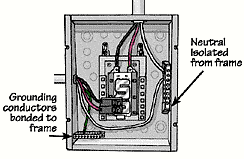Dear
Inspector,
This
month I would like to talk about electrical, specifically,
subpanels and the importance of insulated (aka isolated
or floating) neutral terminal bars.
The
National Electrical Code (© NFPA) has long required
that the grounded conductor (neutral) be isolated from the
grounding system except at the service panel. The 2002 version
of this code can be found in sections 250.24A5, 250.142B
and 408.20.
First
we must understand that the grounded (neutral) conductor
is a current carrying conductor (that's why it is insulated).
Current always wants to return to the source (the transformer)
any way it can. With 120-volt circuits the neutral is the
path back to the transformer for current. The amount of
current that goes out of the transformer must return, otherwise
there is a fault to ground (current traveling through metal
components not designed to be part of the current path).
The electrical device uses the voltage (analogous to pressure)
to create work. A properly installed equipment grounding
conductor will pickup any fault current and provide a path
back to the transformer to complete the circuit and hopefully
clear the circuit by tripping the breaker. This is why equipment
grounds are bonded (electrically continuous) with panels;
to protect the panel in the event they become energized.
Properly
Wired Subpanel

Illustration
Courtesy Code Check Electrica
© Taunton Press
|
When
neutrals and grounds are bonded (connected) together, the
return neutral current will split (not necessarily equally)
and run on parallel paths through the grounding and neutral
system back to the main panel and up the neutral to the
transformer. This parallel travel can cause unbalanced conditions
in the system because the current remaining in the neutral
will not counterbalance the current in the hot wire. The
resulting imbalance creates a magnetic field that can interfere
with sensitive electronic equipment, especially audio and
video equipment. In a metal conduit system, the imbalance
will induce current into the conduit, which could cause
the conduit to overheat. In some cases, neutral current
travel on the grounding system and other metal systems,
such as piping or ductwork, can be a shock hazard.
Equipment
grounds and neutrals should ONLY be connected together in
service panels (this first panel with a disconnect after
the meter). This is where the path to the transformer combines
for both normal circuit flow and possible faults to ground
via the service entrance neutral conductor. The
main panel should be bonded to the neutral terminal bar
to provide a path for fault current should the enclosure
become energized.
We'll
talk next month,
Mike
Casey
Kaplan Professional Schools
Now You're Ready For Business!™